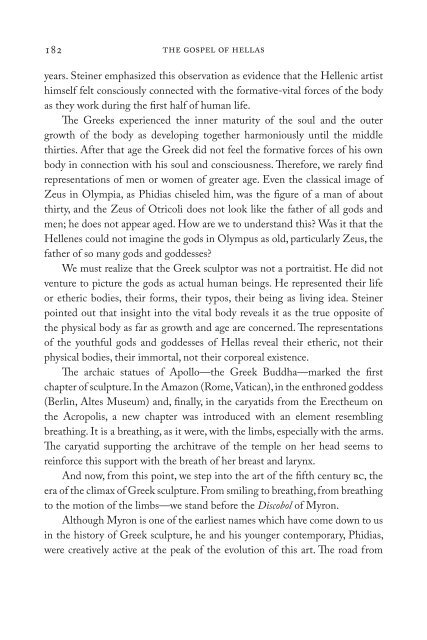The Gospel of Hellas - Research Institute for Waldorf Education
The Gospel of Hellas - Research Institute for Waldorf Education
The Gospel of Hellas - Research Institute for Waldorf Education
Create successful ePaper yourself
Turn your PDF publications into a flip-book with our unique Google optimized e-Paper software.
the gospel <strong>of</strong> hellas<br />
years. Steiner emphasized this observation as evidence that the Hellenic artist<br />
himself felt consciously connected with the <strong>for</strong>mative-vital <strong>for</strong>ces <strong>of</strong> the body<br />
as they work during the first half <strong>of</strong> human life.<br />
<strong>The</strong> Greeks experienced the inner maturity <strong>of</strong> the soul and the outer<br />
growth <strong>of</strong> the body as developing together harmoniously until the middle<br />
thirties. After that age the Greek did not feel the <strong>for</strong>mative <strong>for</strong>ces <strong>of</strong> his own<br />
body in connection with his soul and consciousness. <strong>The</strong>re<strong>for</strong>e, we rarely find<br />
representations <strong>of</strong> men or women <strong>of</strong> greater age. Even the classical image <strong>of</strong><br />
Zeus in Olympia, as Phidias chiseled him, was the figure <strong>of</strong> a man <strong>of</strong> about<br />
thirty, and the Zeus <strong>of</strong> Otricoli does not look like the father <strong>of</strong> all gods and<br />
men; he does not appear aged. How are we to understand this? Was it that the<br />
Hellenes could not imagine the gods in Olympus as old, particularly Zeus, the<br />
father <strong>of</strong> so many gods and goddesses?<br />
We must realize that the Greek sculptor was not a portraitist. He did not<br />
venture to picture the gods as actual human beings. He represented their life<br />
or etheric bodies, their <strong>for</strong>ms, their typos, their being as living idea. Steiner<br />
pointed out that insight into the vital body reveals it as the true opposite <strong>of</strong><br />
the physical body as far as growth and age are concerned. <strong>The</strong> representations<br />
<strong>of</strong> the youthful gods and goddesses <strong>of</strong> <strong>Hellas</strong> reveal their etheric, not their<br />
physical bodies, their immortal, not their corporeal existence.<br />
<strong>The</strong> archaic statues <strong>of</strong> Apollo—the Greek Buddha—marked the first<br />
chapter <strong>of</strong> sculpture. In the Amazon (Rome, Vatican), in the enthroned goddess<br />
(Berlin, Altes Museum) and, finally, in the caryatids from the Erectheum on<br />
the Acropolis, a new chapter was introduced with an element resembling<br />
breathing. It is a breathing, as it were, with the limbs, especially with the arms.<br />
<strong>The</strong> caryatid supporting the architrave <strong>of</strong> the temple on her head seems to<br />
rein<strong>for</strong>ce this support with the breath <strong>of</strong> her breast and larynx.<br />
And now, from this point, we step into the art <strong>of</strong> the fifth century bc, the<br />
era <strong>of</strong> the climax <strong>of</strong> Greek sculpture. From smiling to breathing, from breathing<br />
to the motion <strong>of</strong> the limbs—we stand be<strong>for</strong>e the Discobol <strong>of</strong> Myron.<br />
Although Myron is one <strong>of</strong> the earliest names which have come down to us<br />
in the history <strong>of</strong> Greek sculpture, he and his younger contemporary, Phidias,<br />
were creatively active at the peak <strong>of</strong> the evolution <strong>of</strong> this art. <strong>The</strong> road from

















